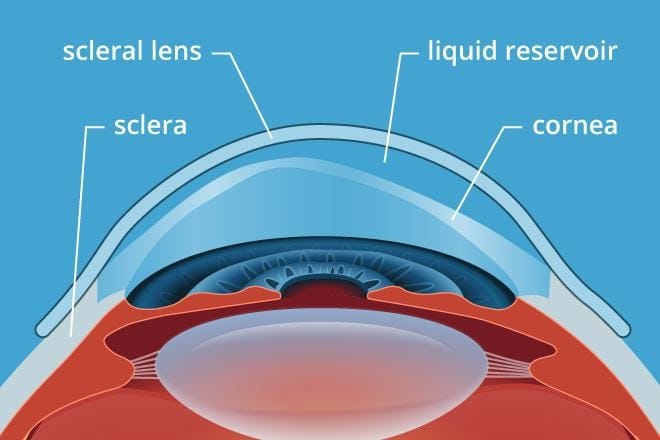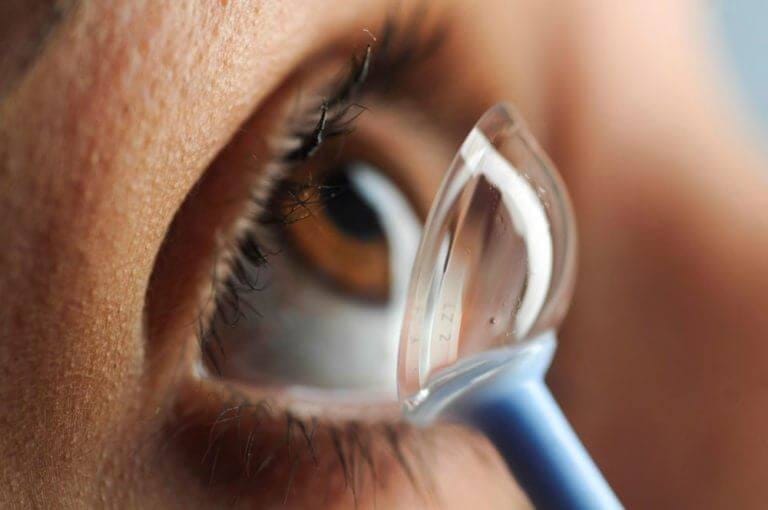20 Facts about Scleral Contact Lenses.
What are scleral contact lenses?
- Answer: Scleral contact lenses are large-diameter gas permeable lenses that rest on the sclera (white part of the eye) and provide advantages such as sharper vision, greater durability, easier handling, and less risk of complications compared to conventional soft contact lenses.
What conditions can scleral contact lenses help with?
- Answer: Scleral contact lenses are particularly helpful for individuals with irregular corneas, hard-to-fit eyes, and dry eyes. They can provide sharper vision for irregularly shaped corneas and offer a comfortable and secure fit for hard-to-fit eyes. Additionally, the generous space they provide can help keep the front of the eye more moist and comfortable for individuals with dry eyes.
What types of scleral lenses are available?
- Answer: There are three categories of scleral lenses: corneo-scleral lenses, semi-scleral lenses, and full scleral lenses, each with different sizes and primary contact areas with the front surface of the eye.
How do scleral lenses differ from conventional contact lenses?
- Answer: Scleral lenses vault over the entire corneal surface and rest on the sclera, providing stability, comfort, and better vision for those with irregular corneas or hard-to-fit eyes. In contrast, conventional contact lenses cover only a portion of the cornea.
What are the disadvantages of scleral contact lenses?
- Answer: Disadvantages of scleral lenses include the need for special training for fitting, higher cost compared to soft contact lenses, the need for daily cleaning, and the possibility of slipping from their position.
Can scleral contact lenses correct vision problems?
- Answer: Yes, scleral contact lenses can correct vision problems such as nearsightedness (myopia), farsightedness (hyperopia), astigmatism, and difficulty with near vision due to presbyopia.
How are scleral lenses different from soft lenses?
- Answer: Scleral lenses are larger, gas permeable, and provide more stability, making them suitable for individuals with dry eye disease, Stevens-Johnson syndrome, Sjogren’s syndrome, keratoconus, graft-versus-host disease, and those who have had corneal surgery.
What is the cost of scleral lenses?
- Answer: Scleral lenses are custom-made and may have higher professional fees and lens replacement costs compared to other contact lenses. However, in some cases, vision insurance may cover a portion of the costs associated with scleral lenses.
How does the space between scleral lenses and the eye benefit wearers?
- Answer: The space between the scleral lens and the eye acts as a tear reservoir, keeping the front of the eye more moist and comfortable for individuals with dry eyes.

Are scleral lenses suitable for post-LASIK or corneal transplant patients?
- Answer: Yes, scleral lenses can be used after LASIK surgery or corneal transplants, as they provide stable and comfortable vision for individuals with irregular corneas resulting from these procedures.
What types of vision problems can scleral contact lenses correct?
- Answer: Scleral contact lenses can correct nearsightedness (myopia), farsightedness (hyperopia), distorted vision (astigmatism), and difficulty with near vision due to presbyopia.
What are the disadvantages of scleral contact lenses?
- Answer: Some disadvantages of scleral lenses include the need for special training for fitting, higher cost compared to soft contact lenses, the need for daily cleaning, and the possibility of slipping from their position.
Do scleral lenses collect debris and need cleaning during the day?
- Answer: Yes, scleral lenses can collect debris and may require cleaning during the day to maintain eye health and comfort.
How do scleral contact lenses differ from soft contact lenses?
- Answer: Scleral lenses are hard, gas-permeable, and larger than soft contact lenses, providing better stability and comfort for individuals with dry eye disease, irregular corneas, and other eye conditions.
Can individuals with dry eyes benefit from scleral contact lenses?
- Answer: Yes, individuals with dry eyes can benefit from scleral lenses, as the generous space between the lens and the eye acts as a tear reservoir, maintaining moisture and comfort for the eyes.
Are scleral lenses suitable for people who have had corneal surgery or LASIK?
- Answer: Yes, scleral lenses can provide stable and comfortable vision for individuals who have undergone corneal surgery or LASIK, especially if they have irregular corneas resulting from these procedures.
What are the different types of scleral lenses available?
- Answer: There are three types of scleral lenses: corneo-scleral lenses, semi-scleral lenses, and full scleral lenses, each with different sizes and primary contact areas with the front surface of the eye.
What is the cost associated with scleral lenses?
- Answer: Scleral lenses are custom-made, and the professional fees for fitting and lens replacement costs are generally higher than those of other contact lenses. In some cases, vision insurance may cover a portion of the costs.
Telescopic Contact Lens-Contact lens with a zoom function
How do scleral lenses provide sharper vision for individuals with irregular corneas?
- Answer: Scleral lenses vault over the entire corneal surface and rest on the sclera, providing stable and comfortable vision for individuals with irregularly shaped corneas and correcting their vision problems.
How can you put in scleral contact lenses?
This tutorial will guide you through the process of putting in your scleral contact lenses using two common methods: the tripod or three-finger method and the DMV scleral or plunger method.
Materials Needed:

- Scleral contact lenses
- Preservative-free saline solution recommended by your eye doctor
- Flat mirror
- Lint-free cloth or towel
- Mild soap
- DMV scleral or plunger (optional)

Instructions:
- Wash Your Hands: Start by washing your hands thoroughly with a mild soap and water. Dry your hands using a lint-free cloth or towel to prevent lint or debris from transferring to your lenses.
- Eye Inspection: Place a flat mirror on the table in front of you and inspect your eyes for any redness, discharge, or abnormalities. Ensure that your eyes are in good condition before inserting the lenses.
- Check the Lens: Hold your scleral lens up to the light and carefully check for any chips, debris, or white/cloudy spots. Ensure the lens is clean and in good condition.
- Tripod or Three-Finger Method:a. Hold the lens with your thumb, index, and middle fingers. b. Fill the bowl of the lens completely with preservative-free saline solution to prevent air bubbles. c. Ensure your body is parallel to the floor, look downwards at the mirror, and use your non-dominant hand to hold your upper and lower eyelids open. d. Move the lens toward the center of your eye. e. When you feel the solution against your eye, gently press the lens to your eye and release. The lens should adhere to your eye. f. Blink several times to help the lens find the correct position on your eye.
- DMV Scleral or Plunger Method:a. Lightly squeeze the grip of the DMV as you place the lens in the center of the plunger. b. Release your grip on the DMV once the lens is positioned and suctioned to the DMV. c. Fill the bowl of the lens completely with saline solution to avoid air bubbles. d. Look straight down at your mirror or fixation dot, use your non-dominant hand to hold your eyelids open. e. Move the DMV toward the center of your eye. f. When you feel the lens touch your eye, lightly squeeze the DMV to release the lens. g. Blink a few times to help the lens find the correct position on your eye.
- Repeat for the Second Lens: Repeat the process for your second scleral lens, ensuring proper insertion for both eyes.
- Comfort Check: If you experience any discomfort following the insertion of your scleral lenses, remove the lenses and insert them again. If discomfort persists, consult with your eye doctor promptly.
Follow us in Facebook

You must be logged in to post a comment.